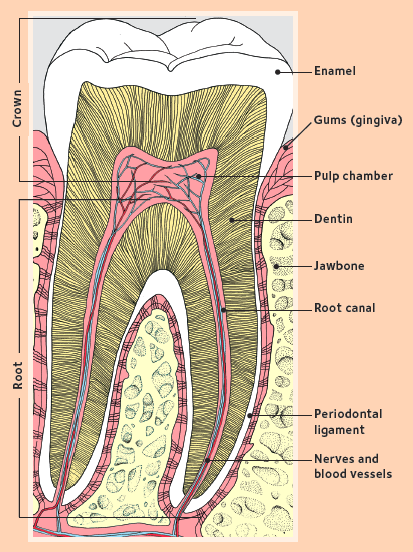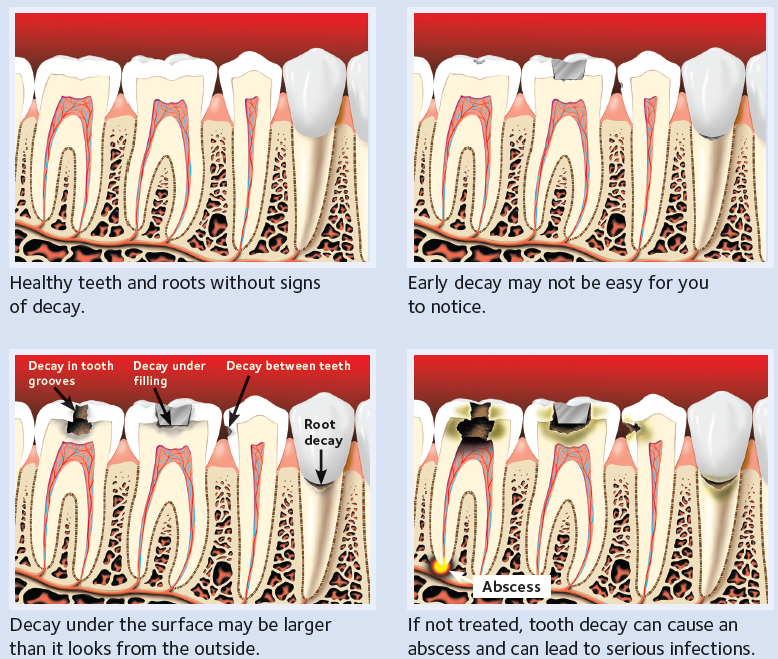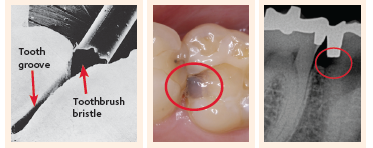Your dental hygienist at your Aspen Dental practice can show you the proper way to brush and floss—two things you can do every day to help prevent cavities. Learn helpful tips on brushing and flossing.
Tooth Decay
Some people think only children get tooth decay, but all of us are at risk our whole lives. The good news is that tooth decay can be prevented. By following a healthy oral care routine and making smart food choices, you can lower your risk for tooth decay.
What is tooth decay?
Tooth decay is a disease that damages and breaks down teeth. Your teeth have a hard outer layer (enamel), a middle layer (dentin) and a center (pulp).
Diagram of a Healthy Tooth


What causes tooth decay?
Your teeth are covered by a sticky film of bacteria called plaque. After a meal or snack, the bacteria turn the sugars in foods and drinks into acid. The acid breaks down the enamel of your tooth. If the decay gets through the enamel, a hole, or a cavity, can form. Once the cavity forms in the enamel, it can continue to spread deeper into the layers of your tooth.
If tooth decay is not treated, you may feel pain, the infection can spread to other parts of your mouth, and you may even lose teeth. People with tooth pain often have trouble eating and sleeping and may miss days of work or school.
Signs and symptoms of tooth decay
- spots on your teeth
- bad breath that doesn’t go away with brushing or mouthrinse
- loose fillings
- sensitivity to heat or cold
- tooth pain
You may not notice any signs or symptoms at all, so it’s important to see your dentist regularly. They will examine your teeth and take X-rays if needed.
Can you pass tooth decay on to someone else?
Not exactly, but the bacteria that cause tooth decay can be passed from one mouth to another by kissing, sharing a cup or spoon, or anything else that carries a drop of saliva. Do not share toothbrushes with anyone else, either.
Common places where decay forms
Tooth decay can damage any tooth. It often occurs between teeth and in the grooves of back teeth, where bits of food collect. Toothbrush bristles do not get into these grooves. Back teeth are also harder to keep clean because they are not as easy to reach. Another place decay can form is at the tooth root. Cavities here may go below the gum line.

| Even a toothbrush bristle is too big to reach inside a groove in the tooth (magnified). | Tooth decay can form under fillings. | X-ray of tooth with decay under a filling. |
People of all ages can get tooth decay
Your risk may increase if you:
- often snack and sip on sugary foods and drinks
- have dry mouth
- have weak enamel due to family history or a childhood illness
- do not take good care of your teeth
Treating tooth decay
Treatment depends on the size and location of the decay.
- For decay that is caught early, fluoride treatments may be all that is needed.
- If decay has formed a cavity, you’ll need a filling.
- If the cavity is large, you may need a crown.
- If the cavity has caused the pulp of your tooth to be infected or inflamed, you may need a root canal.
- For a tooth most badly damaged by a cavity, it may need to be removed and replaced.
What you can do to lower your risk of tooth decay
- Brush your teeth with a fluoride toothpaste 2 times a day and for 2 minutes each time.
- Clean between your teeth every day with floss or another between-the-teeth cleaner.
- Limit how often you snack and sip on sugary foods and drinks.
- Drink water with fluoride as much as possible.
- Visit your dentist regularly for an exam and a professional teeth cleaning.
- Dental sealants applied to back teeth (molars) are a treatment option that can lower your risk even more.
- Use oral care products that have the American Dental Association’s Seal of Acceptance. It means they have been tested and show they are both safe and effective.
Saliva helps prevent tooth decay, too. It reduces acid damage to teeth by washing away sticky, sugary foods. Saliva also makes acids weaker. The minerals in saliva can help repair teeth. Chewing sugarless gum or sucking on sugarless hard candy after eating can increase saliva flow and help rinse away sugars.
Decay under a filling photo captured by Dr. Joseph Nelson II.
X-Ray of decay under a filling photo courtesy of Dr. Padmaja Mutyala.
This ADA educational message displayed by permission.

